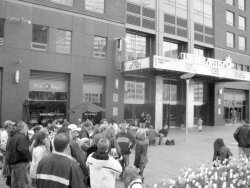Wet Fern: Dry eyes rare at Matthews debut
Last Saturday, just a block from New York's Ground Zero, the world's most eagerly awaited phoenix, a troubled film enjoyed a rebirth of its own. Where the Red Fern Grows, the motion picture debut of Dave Matthews, drew a solid ovation and moistened several hundred eyes at its May 3 premiere.
"I cried the whole way through," said Megan Lewis of Westchester County, following the screening at the Tribeca Film Festival. Although acquainted with one of the film's producers, the 40-something audience member says she didn't realize how well the 36-year-old rock star could act.
"I was a little bit skeptical, but he pulled it off," said Lewis. "Dave Matthews did a great job– so subtle, so understated."
(Charlottesville audiences might be less surprised. In 1990, before creating an eponymous platinum-selling quintet, Matthews starred in the first seasons of both Live Arts and Offstage theater companies.)
At film's end, the rapt six-and-a-half-year-old who'd been sitting next to a reporter pronounced it "great." "But it had some scary parts," he added, quickly erasing tell-tale teardrops.
"Dreams really do come true," casting director Katy Wallin proclaimed when the applause ended. Wallin, who assumed a leadership role in getting the film off the skids and onto the screen, beamed when a reporter described as "seamless" the merger of scenes shot in 1999 with those shot in 2002.
"I'm so happy you said that," said Wallin. "Seamless– that's such a great word."
Many in the audience had no idea that the film actually began as the brainchild of a now bankrupt screenwriter/director who lost rights to his project after shooting about 75 percent of it on location in Tahlequah, Oklahoma, in the fall of 1999.
Lyman Dayton, who also directed the 1974 film version of the Depression-era tale, had dreamed that his remake would pick up the pace for modern audiences– especially by showing more raccoon hunting. Ironically, most of the animal sequences were shot by his replacement. Sam Pillsbury, a veteran director of made-for-TV movies (with the notable exception of Free Willy 3: The Rescue), shot most of the 'coon hunting sequences last summer on a Walt Disney lot in Southern California.
One audience member lauded Pillsbury's "vision," and Pillsbury said he was "pleased with the way it came out"– but passed up the chance to share the credit with the absent Dayton.
The next audience question: Were there any "obstacles" to making this film? This time Pillsbury deferred to producer Katy Wallin who smilingly dodged, "We tried to turn obstacles into opportunities." Next question please!
Outside the theater, workers were busily fixing utility connections in the world's most famous pit. Under a construction canopy below the pock-marked brick facade of the Barclay-Vesey Building, hawkers offered World Trade Center memorabilia.
The theater, a United Artists/Regal 16-plex, was undamaged by the 9/11 attack, but the catastrophe nevertheless closed it for nearly seven months. The Tribeca Film Festival, now in its second year, was created as an overt balm for the beleaguered neighborhood.
In the tradition of Old Yeller and My Dog Skip, the film is a tragic boy-and-his-dogs story. Red Fern is a modest-budget family picture based on a book that's required reading in many– if not most– of America's middle schools. It features several megastars of the 1970s: Kris Kristofferson, Ned Beatty, and Mac "I Believe in Music" Davis.
In the Q&A following the screening, most questions were directed to 16-year-old Joseph Ashton, who plays the young protagonist, and to 71-year-old Dabney Coleman, who plays his devilishly good-natured grandpa.
"To tell you the truth," said Coleman, "I'd never heard of David Matthews, but we hit it off pretty well right from the get-go. I really miss him."
Dave didn't attend the premiere, and his Greenwood-based handlers did not return calls seeking comment. He plays the supportive dad, Will Coleman (spelled "Colman" in the book), in all earnestness. One of the film's highlights comes when his son sells enough coonskins to buy dad a new pair of overalls.
"They're fine hounds, son," is one typical bit of Dave dialogue. Here's another: "It's great to see a big coonskin on the smokehouse wall in the morning."
This is not a film for jaded modernists.
Jeanette Garvey traveled from Ohio to attend the Tribeca Festival. And she'd heard about the film's circuitous journey. "The final outcome was a great success," Garvey said. "I fell in love with the dogs– even the raccoons."
Meanwhile, back in Tahlequah, the tiny Oklahoma town where filming began– and abruptly ended– in the fall of 1999, unpaid merchants are still fuming.
X-Press Rental and Sales, for instance, never got a penny of the approximately $3,600 it was owed, says owner Foix Stauss. "This community opened its arms, but they crapped on everybody," he adds. "The Screen Actors Guild made sure all the actors got paid, but no one here has ever been paid."
The Tribeca premiere attracted little media interest– although a camera crew from Variety busied itself getting pictures of the young star, best known until now for his pre-teen starring role in The Education of Little Tree.
Conventional wisdom says that a movie about a boy and his 'coon hounds is headed straight for Sunday night television, but the new owner of the picture, Crusader Entertainment, is holding out for theatrical release.
"We're screening it for distributors now," says the company's chief operating officer, William J. Immerman.
